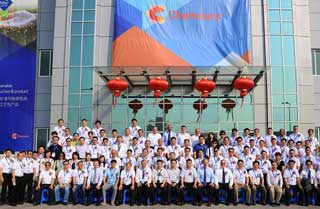Chemours opens Teflon plant in China; reports 2nd quarter loss; faces Teflon lawsuits in the US

US chemicals firm Chemours has opened a new Teflon finishing plant at its Changshu Works site in Changshu (Jiangsu), China. Chemours says it invested US$15 million in this plant, which will enhance and expand its production and cater to demand especially in China and the Asia Pacific region. Polytetrafluoroethylene (PTFE) is a synthetic fluoropolymer of tetrafluoroethylene and the best known brand name of PTFE-based formulas is Teflon.
“The Teflon brand is trusted worldwide and our new finishes plant will have the technological capabilities to maintain the superior product standards expected from the brand,” said Jeff Jirak, Global Business Director Chemours Fluoropolymers. “At Changshu, we will be able to leverage existing infrastructure to provide greater flexibility in developing PTFE dispersion coating formulations that are customised for our customers’ needs.”
This new plant will augment Chemours’ already considerable presence in China, which includes a new coatings R&D centre and technical service lab in Shanghai. That facility opened earlier in 2016, not only as the centre of development for new coatings, but also to support customer needs in China and across Asia.
Meanwhile Chemours, spun off from DuPont’s performance chemicals business last year, recently reported a second-quarter loss of US$18 million, which equals the US$18 million loss for the corresponding period last year, the final quarter before completion of the spin-off. It has, thus, posted losses in three out of four quarters since becoming an independent company.
However, CEO Mark Vergnano said the company is “gaining momentum this year from the success of our transformation plan, including cost reductions and portfolio optimisation.” The company has sold its aniline facility in Texas to Dow Chemical for US$140 million and its sulphur products division to Veolia North America for US$325 million. It has also sold its Clean and Disinfect chemical business to German company Lanxess for US$230 million.
It is also hoping to build on its leading market positions in titanium dioxide, a whitening pigment used in a variety of industrial applications and consumer products, and in fluoroproducts such as its environmentally friendly Opteon refrigerants. In the second quarter, titanium sales were US$596 million, a 7% decline versus the prior-year quarter, while fluoroproduct sales declined by 3%.
Teflon lawsuits in the US
But its Teflon business has had adverse publicity more recently. It has been in commercial use since the 1940s and is mostly used as a non-stick coating surface for frying pans and other cookware as well as in fabric protectors. Perfluorooctanoic acid (PFOA), also known as C8, is another man-made chemical used in the process of making Teflon and giving frying pans the non-stick surface. Although it is burned off during the process and is not present in significant amounts in the final products, PFOA has the potential to be a health concern because it can stay in the environment and in the human body for long periods of time and this is a cause of concern.
3M Co. originally made the chemical and sold it to DuPont. When 3M phased the chemical out in 2000, DuPont started making its own. Neither company uses it anymore. A reformulated version is used in products such as fabrics, small appliances and components used in food processing.
In the US, in Ohio and West Virginia, there are some 3,500 lawsuits involving alleged health problems related to exposure to PFOA. While DuPont has been named defendant in each case, it claims it is entitled to indemnification from Chemours for any damages. Two of those cases have gone to trial, with the defendants being awarded US$1.6 million and US$5.1 million in damages, respectively.
“This type of litigation typically takes place over many years and interim results do not predict the final outcome of cases,” Cynthia Salitsky, a Chemours spokesperson said in a statement.
Stalitsky also said Chemours might challenge its responsibility for damages. “DuPont is the named defendant in each of the cases and is directly liable for any judgment. In the event DuPont claims that it is entitled to indemnification from Chemours as to some or all of the judgment, Chemours retains its defenses to such claims,” she added.
(PRA)Copyright (c) 2016 www.plasticsandrubberasia.com. All rights reserved.












































